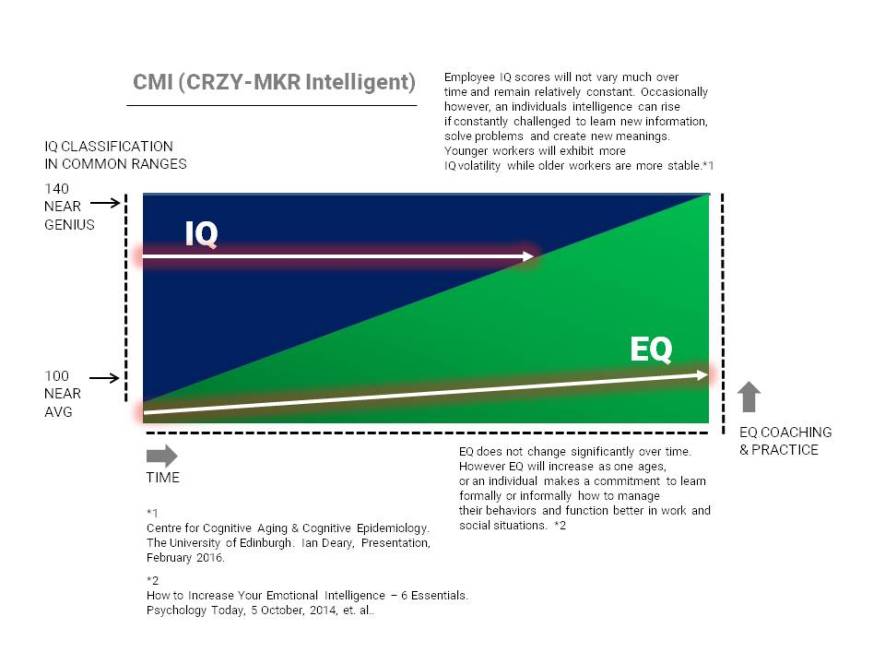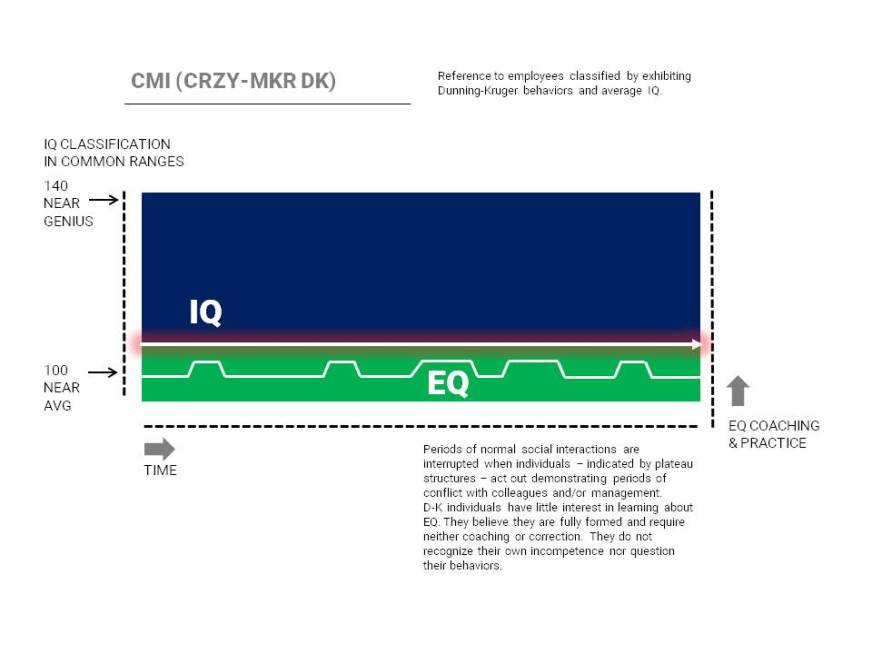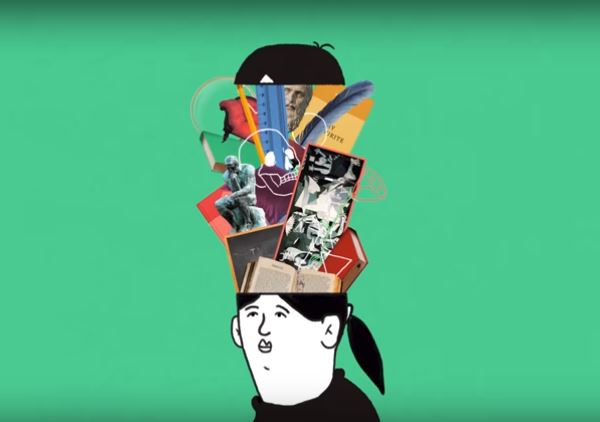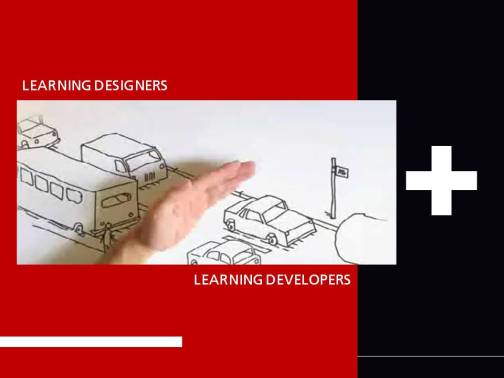Yes, they are all around you. Can you see them, hear them, smell them? Recognize the danger early—you’ll save yourself and your enterprise. The CRZY-MKRs haven’t erupted from the earth, half-dead as decomposed zombies coming for your life force. Worse, they’re coming for your mind. Ultimately, such destructive individuals are most capable of harming the most fragile commodity in any company: the creativity of a person, persons, and inflicting fatal wounds on the organization. No successful entity can move forward without people willing to take risks that demand out of the box thinking and have a tolerance for failure, especially if it keeps them on the path to achievement. A CRZY-MKR can very easily undermine this type of employee—wearing them down with distraction. Since creative work is always ahead of the status quo, it is visible and vulnerable, fragile. In the short and long term, these two disparate things, creativity, and CRZY-MKRs are inextricably linked: the designer and critic, the theoretician and the dinosaur, the what if and the status quo. Businesses can only thrive when they eradicate CRZY and encourage risk safely—in thought, action, and deed.
Who are the CRZY-ONEs?
In large organizations they are at every level dispersed like a virus, in small organizations, they are a sneeze—even closer and perhaps more deadly. They have very poor or underdeveloped emotional intelligence. We are not alluding to gossip mongerers – that may be one trait of a CRZY-MKR but just part of their toolset. Most importantly – and we’ll tackle this later—it’s imperative for individuals and organizations to deal with CRZY-MKRs in a decisive way before they habituate behaviors that chip away at employees emotional security. An exodus of talented individuals who succumb and bolt for the exits may hijack a whole organization and render it toxic.
When referring to CRZY-MKR personalities we might classify them as CMI (CRZY-MKR Intelligent) & CMDK (CRZY-MKR DK).
CMI: We need keen observation and vigilance to uncover this behavior. An individual who presents a composite series of traits that cause others to distraction or dysfunction is often described as intelligent, cognitive, and even meta-cognitive—but venal—is CRZY-MKR Zero and might indicate they are on a socio-pathological spectrum.

CMDK: Alternatively, we could examine an individual who is relatively unskilled or less knowledgeable. Their delusional personality prevents them from recognizing their own incompetence and this cognitive bias leads to inflated self-assessments and illusory superiority. They don’t know what they don’t know but see their reflection as chimeras. (The Dunning-Kruger Effect – 1999). We’ll refer to that person as CMDK (CRZY-MKR DK).
 Summing up this section, the intelligent person knows what they don’t know and works to their strengths while learning to make up for their deficiencies, whereas the less skilled and incompetent hides deficiencies by inflating their own sense of intelligence and achievement—lying to themselves while projecting their fake accomplishments to the social order. One is a CRZY-MKR who is smart and competent but totally self-absorbed. And have poor emotional intelligence.
Summing up this section, the intelligent person knows what they don’t know and works to their strengths while learning to make up for their deficiencies, whereas the less skilled and incompetent hides deficiencies by inflating their own sense of intelligence and achievement—lying to themselves while projecting their fake accomplishments to the social order. One is a CRZY-MKR who is smart and competent but totally self-absorbed. And have poor emotional intelligence.
They often exercise power to undercut someone they see as a threat (or for kicks – if they truly are on the CRZY spectrum) ; or in the latter definition a CRZY-MKR is an incompetent harboring a composite of traits that seeks to ratchet up their own self-image by diminishing others thus, by comparison, appears competent, clever or smart.

1. Find Them Out in the Open – or Zombies who Strike in the Dark
These actions are applicable to either CMI or CMDK individuals.
Recognize them by what they do.
- They make you second guess what you know to be true
- They impede your progress on projects by drawing you to off-task tangents
- They sow the seeds of doubt
- They are Me- rather than We-Centric
- They are caffeinated conversants who manage to say nothing while sounding smart and sane
- They pretend to listen but really only care what it is they are saying – then accuse you of not listening
- They traffic in he said/she said stories ensuring you have to look over your shoulder to make sure no one is coming at you
- They suggest you have made an enemy in the organization and you’re unaware, naïve and blind
- They are so convinced they are right they will go to any lengths to ensure their one right answer is the only acceptable one
- They use whatever real power they have to push you off your working methodology and accept theirs – doubling your efforts by forcing you to learn new ‘formats’ while you are simultaneously solving problems
- They will steal or chip away at your productivity
- They will dole out compliments and kudos and a nanosecond later ask why you did THAT!
- They will triangulate even so far as to have a colleague replicate your project to instill competition instead of cooperation—then broadcast this as important “news”
- They weaken the total organization by unbalancing individuals, teams, projects, ideas.
2. Characteristics of CRZY-MKRs
They can be colleagues, equals in rank and maybe even a work buddy, but most employees exhibit some form of CRZY when they lose control of their better nature – or fearful for their own future. Or maybe they were just born or raised to be vindictive. They became insidious saboteurs. Learning on the job to get ahead by kneecapping others is not a hard lesson to learn – but the truly dangerous CRZY-MKRs are subtle, selective and have acquired an amazing sense of timing. Thus, their stealth goes undetected except for the inevitable effects on others. It’s an excellent technique for ramping up their targets’ paranoia.
In the natural world, a lion shakes off its torpor when a gazelle is limping along just a little bit – or when the millionth particle of blood in seawater is vacuumed up by a great white, or a furtive assassin knows the victim’s schedule and vulnerabilities. An employee saboteur knows the soft underbelly of today’s target – trouble on a project, a rift between team members, sour negotiations with a vendor, an experiment hobbled by blind alleys. They’ll make sure management knows. Then they’ll let you know, that they know, and how they’d be glad to help you get on track.
Now that we have defined whom and what CRZY-MKRs are here’s a few examples:
Let’s start with the most dangerous CRZY-MKR – a superior, supervisor, employer. We assume they are intelligent so consider them the lion and you the gazelle.
3. The Case of the Sleeping Consultant
A consultant is hired to resolve a communications problem the senior executive has neither the time nor skills to complete. The executive is very smart but in specific sectors of business – a typical CMI – and believes he has excellent people skills.
- A price is agreed upon aligned to a deliverable somewhat defined (Error #1 inviting in CRZY – and these are failures of the
 consultant to call the executives behaviors in to question).
consultant to call the executives behaviors in to question).
- The consultant is shown an example of the type of deliverable required gets confirmation from the executive and produces a proof of concept.
- The POC is rejected as the executive says the content is wrong—as is the design.
- The executive says hold up until we can get aligned. Two days pass—freezing the consultant from taking on other work. (Error #2 – No recognition or consideration of the consultant’s time)
- The executive then calls the consultant after producing a configuration of what he is looking for. The consultant attempts to gain an understanding of what exactly will meet the specification. Yet the deliverable still has vagaries (Error #3 Failure to get final clarity).
- The executive says, just look at my work, and follow it.
- The executives’ examples do not meet the spec either; however, the consultant does complete all the written material and examples of a solution.
- The executive once again rejects the work – even though his specs were not only unaligned, neither well defined, nor prove to be an exemplar or model to replicate. The executive is clearly frustrated – saying he does not have the time to provide an example.
- The consultant makes it clear he has dedicated many hours to the project to which the executive replies, essentially that’s impossible; HE could do it in an hour! When the consultant suggests they get on the phone together, spend 45 minutes producing a perfect model, the executive says it will take him 2 ½ hours to complete. The consultant is now fully suicidal. (Error #4 – Obviously the executive is a CRZY-MKR and the consultant should have recognized this earlier)
- The executive issues an edict: “Finish the project or you won’t get full payment.”
- The consultant says if you provide an example, I can do that.
- The executive says he does not have the time.
- The consultant says, “I’m billing you for the work I have completed.”
- The executive says, “Complete the project and I’ll pay you the full amount.”
- The consultant replies that unless he has an example – which the executive will not provide – he cannot.
- The executive says, “Finish the project and I’ll pay you the full amount.” (CRZY). “If you don’t, I’ll pay your bill but do not expect more work from me.”
- The consultant – accepts he is dealing with a CRZY-MKR says,” Pay me what you owe me and have a good life.” Then he stops wasting his time and captures another client.
In the end, the consultant should have been more alert to the signals sent by the executive and acted to extract himself from the situation earlier. You can hear the control needs, the superior power position, and elevated threats. A key signifier and most detrimental element to an achievable solution is the vacillation of the executive back and forth – a clear sign this is a CRZY-MKR in Technicolor. Nevertheless, the other lesson is the gazelle needs to run faster and be more alert to survive the lion, and despite the big cat’s power, usurp control from the executive with the forcefulness of a positive NO! (William Ury – The Power of a Positive No., December 2007). Clearly, the contract will be lost: better a small piece of business than the billing hours lost trying to extrapolate the actual specs from a power broker who would not cooperate. Remember, thinking and discussing takes time which costs the consultant money.
4. The Case of the Jealous Mentor
A very experienced long time employee volunteers as a mentor. Once vetted by management she is assigned to work with a novice customer sales representative, recently graduated from 14 days of training, to improve and assist her use of CRM templates, product knowledge, and sales skills. The mentor has worked in this sector with these products, her entire career. New to the field, the novice, who has experience in other sectors, eagerly cleaves to the mentor for guidance, advice, and coaching. They are seated adjacent so the mentor can listen in on calls made by the novice.

During the first ninety days the following occurs:
- The novice listens in on the mentors’ calls
- The mentor guides the novice through the templates and completion of the CRM fields
- Eventually and slowly the novice begins to take calls, enters information into the CRM
- Turning to the mentor when at a crossroads, or not sure of next steps, the novice is still somewhat reliant on the mentor.
- As the ninety-day period ends, the novice is knowledgeable, skillful and has the added ability to manipulate her voice to meet the customer at their comfort level.
- Eventually, at one hundred twenty days, the novice is steady, capable of making independent, quality decisions, applies practices and knowledge learned in former positions and has a cadre of customers with whom she has cultivated positive relationships.
- As the quarter draws to a close, the former novice’s sales are equal to that of the mentor.
- The mentor, during one lunchtime walk with her closest work friend, suggests she is worried about her mentee and is making errors that management is failing to catch.
- Her friend shows concern: such behaviors can reflect poorly on other reps and the company
- The mentor decides to send an email to their supervisor asking if her mentee has had extensive sales experience with other product lines dissimilar to the companies.
- The supervisor has now been called in – and begins informally, to recheck the mentees work history and further instigates a schedule to listen in on a random sampling of phone calls made to customers by the mentee.
- The mentee grows in value to the organization earning rewards from human resources for quality communications and from her sales division head for capturing new customers – and holding to full price.
- The mentor asks the supervisor what became of her findings. The supervisor is forbidden to share information about one employee to another but mentions she is watching closely.
- By this time the mentee, once growing in confidence, is aware he former mentor no longer banters with her, nor does she provide guidance unless specifically asked.
- Aware her intuition is calling to her executive brain, the mentee approaches the supervisor inquiring if there is a problem with her performance of that she should be aware.
- The supervisor suggests she do two things: work more closely to company policy and not rely so much on her past knowledge and skills but ‘stick to the company script’ and work harder at building better relationships with her
- The mentee is confused. She has been successful in every dimension of performance and has never received any formal nor even informal assessment and, further, senses she is now viewed with a negative bias.
- She decides to elevate her concerns approaching the HR head in the section. She is told essentially, what her immediate supervisor said to do. When asked if there are problems with her results or behavior she is was only told, again, to ensure her activities meet company guidelines and then dismissed with a ‘not to worry about it’.
- After a few weeks pass, the supervisor calls the former mentee to her office for a ‘chat.’ The mentee is told her phone calls while resulting in a fair return on business, were not as strong as they could be – and deviating from a specific script was to stop. The mentee knows from experience that at this and other companies a representative must veer from the script if the customer’s needs are not being met. The supervisor suggests that continuing to ‘free-lance – is upsetting other reps and if it becomes known she has special dispensation then all reps will begin to ‘wing it.’ Realizing further conversation would lead to a more heated discussion, the mentee leaves. Of course, she asks herself how the supervisor knows of calling language, and even if listening in, could not know everything she has done. Someone is spying and sharing her activities sabotaging her reputation by mischaracterizing her use of other knowledge and sales techniques.
- She immediately goes to her cubicle and starts refreshing her Even though is leading in sales entering the new quarter, her position at this company is no longer tenable, nor a good fit.
The result here is the company loses a quality individual because of hearsay and innuendo. With kindling provided by her former mentor – a well-respected and senior individual – then fanning the spark into a fire when the supervisor asks seemingly innocent questions. This touches the supervisors need to run a smooth operation and finally HR who believes they may have a long-term problem within the department if the mentee is retained. They were moving to make a case for dismissal when the mentee suddenly resigned. Others in the department were mystified—and ask amongst a large cadre—why would someone so successful bolt from a position where she was very successful, well liked and socially inoffensive. Each individual rep is now left with a touch of paranoia – since no reason is provided by the supervisor nor HR for a talented rep’s resignation – particularly one who exceeded expectations, received awards for performance and was well-liked by customers and other personnel.
By now, you know why. A CMDK with seniority was threatened. With her length of time on the job, knowledge of products and the CRM, she fell behind her own trainee in all aspects of performance. Soon, she felt, questions would be asked of her and with little outside experience knew if she lost this job, finding another similar position would be difficult. Instead, she felt the tug of the lion and proceeded to strike at the mentee in her soft underbelly. With less seniority, lack of experience is this sector and reliance on other techniques—not necessarily endorsed by the company—such examples will be enough rationale for saving herself in the guise of protecting the company.
5. Summation
A CRZY-MKR particularly adjacent physically in a cubicle type office or within your department or team is relatively easy to diffuse, unmask, and defang especially if you are not the only one to recognize their charade. CRZY-MKRs are like serial killers: they need to act out often to be satiated. The chances are high she has done this before. Had the mentee known that she might have formed trusted relationships with a few other reps and without much prompting, heard the ‘war stories.’
Your objective, if a target, is to call out the negative behavior, confront the individual revealing that you know what is going on. Then label the individual a CRZY-MKR. Fortunately, a CRZY-MKR has more than one target so communication among ‘victims’ leading to a definitive unmasking, and, if quite toxic, bring to management for corrective action or termination. But the best result you might want to seek – by letting this person know you have discovered this nefarious, habituated behavior, is to get them to accept behavioral change—now and in the future. And the closer to the ground – that is on your level in the organization – prior to alerting higher authorities might gain a positive result simple by keeping it local. Bear In mind, however, few if any CRZY-MKRs have poor emotional intelligence and will view an attempt to ‘correct’ them to be tantamount to a declaration of open warfare.
If the CRZY-MKR is a manager you should know there is always someone he or she reports to. However, have your evidence codified: a diary of events and examples, detriments to working conditions, emotional and actual damages to you, your ability to satisfy tasks and state of mind. With the corroboration of other similar targets, you will alert management that this is not a personal vendetta, rather a systematic condition requiring inoculation or extermination. Awaken complacent or unaware management to minimize blowback or payback – subtle or public. Quality leaders will know it’s time to address cultural norms to save the company. If not, you have to leave.

The 4.1 Workplace Elements for Survival
Manage Expectations
Like a great quarterback, who knows every player’s assignment on every play or a superior actor who knows, not just his/her lines but everyone else’s, you need to manage the expectations the company has for you, within your team, division, the organization as a whole. You have to demonstrate you can not only exceed at your job but also be known as the reliable, steady playmaker who goes the extra mile to improve performance, make the atmosphere pleasant, add to the positivity of the workplace. Know your job, your supervisors’ jobs, and their superior’s job. No one dares ‘go zombie’ at an employee who has built a reputation of legitimacy.
Accumulate Leverage
In this case, leverage is empowerment you’ve earned and like money in the bank can be cashed in when you need to achieve a goal, get assistance, or seek protection from a CRZY-MKR. To gain empowerment you need to give to get. Helping out others, doing small – or large favors – jumping in to assist on another project outside your normal working tasks, being present to support or add effort to meet a deadline, make a sale, improve UX/UI, lend your talents where needed in situations where that talent is not present in the organization are ways to show you are a team player. Even bringing in small gifts for holidays is like money in the corporate piggy bank. These efforts have great visibility and the immediate interest you will earn. The more people who see you participate the higher your value goes earning thanks and a reputation what others will remember and most will gladly return. For our purposes, it makes a CRZY-MKR realize you have no soft underbelly or if so, have enough value to question anyone who cast aspersions at you.
Promise and Deliver
Nothing earns favor more in teams, divisions and entire companies than a person who says what they will do and then does it – on time, on budget, satisfying internal and external customers, completing your leg of a finish-to-start project. Consistent dependability earns mind space in the executive ranks; that is you’re known as the man or woman who gets it done – sometimes when no one else can. Taken for granted this way is a plus – no manager will climb on your back or question your capacity to deliver if your history proves it’s unnecessary to think about you at all – in this case, a good thing. Better still – who would ever come after you with innuendo, question your methodologies or intelligence if your production goes unquestioned. Well, a CRZY-MKR might get miffed and start a sabotage routine but it’s they who will be sharply questioned about their motivation. You are kryptonite to a CRZY-MKR. They’ll seek out a weaker target – a slower gazelle.
Think Through to the Endgame
Today’s achievements have the shelf life of milk. Success is built brick by brick over periods of time. Immediate wins are great, but if they are that easy, some might say we expect even more from you. Smart employees at any level look over the horizon about what they need to do now to get to where they want to be in the future. That includes getting on projects that don’t have quick payoffs but could shift the direction of the entire company. Contributions to a far-off goal demonstrates you have staying power, continually offer ideas, fill voids, pick up the slack, think out of the box, invent, create and model behaviors that will go noticed. So if there is no pat on the back today – you must believe – with your help – the end will justify the effort you have put in. Sometimes low hanging fruit even if eaten today has worms – on the higher branches ripening in the sun and rain are the tastiest apples, peaches, and pears. What this means is simply think long term. As long as you are contributing, you are most likely appreciated and inoculated from CRZY-MKRs. Of course, there might by such a person on – or leading this endeavor. In that case, continue to be indispensable whether that individual recognizes it or not. Most likely, everyone else will.
And finally…
Make the Shift to Offense
If you find yourself in the crosshairs of a CRZY-MKR and you have successfully identified that individual and what they have accomplished to your detriment – at that exact moment invite him or her to lunch. That’s right – buy the person lunch. Here, away from his or her defensive fortress layout what you know or even suspect. Ensure the CRZY-MKR, even if that person is your boss, understands there are consequences to this type of behavior. Be emphatic – no matter whether they deny it or not – assume they are lying and layout your attack strategy. Your armaments should consist of: a diary of what you have done on the project(s) they are critical of, suggest your colleagues know of this situation, another supervisor is on notice this behavior is ongoing and your future steps including HR or even an outside organization or that your attorney is ready to come in to play. End by stating emphatically – “This ends now,” and go back to that person or persons you spoke with about me and apologize saying you got it wrong.” Give them a timeframe – short – for you to hear from them how much you are appreciated. Then suggest you can play at this as well but you have more important things to do… and senior executives need to hear about. Regardless of how you spin it the message is: I know what you did. You need to reverse field. I expect proof it has been done. If not expect an asymmetrical response from me which will be worse than you can imagine. Then get up and walk away.
Lastly, here are a few freebies I gladly pass to you. I learned by experience, though I read all the business books and still do since changing careers from public education to the corporate world 22 years ago and over 40 years in all sorts of trenches – sometimes digging them. Other times planning their layout and in other cases having them designed for my approval:
- Colleagues are not friends.
Nope, sorry. That guy you play handball with, barbecue, or golf will turn on you in one second if the economy or reorganization comes and personnel cuts are likely. We all want to pay the mortgage, eat, buy cars, take vacations or just squirrel away money and retire early. If you are in the way of that or on the same ladder as are they, loyalty goes out the window.
- Stay current.
Particularly now, in times of rapid disruption in virtually all fields, today’s information is historical and the future built on virtual blocks you can’t even see. Its incumbent upon anyone on a career track learns everything and anything even if tangential to your field. Moreover, keep in mind the tiptoes you hear behind you is the next generation of workers who were brought up already knowing this stuff. Whether learning on your own or taking a course – get and stay smart and contemporary.
- Hone your intuitive and listening skills
What else needs to be said here? Well, I still get one deaf to my intuition and it’s been to my deep regret and injury. I hear it sometimes but fail to take heed. Practice with mind games – there are so many online. Turn off the TV and teach yourself to think differently and you’ll open up new neural pathways and your inner vision will improve. The good Lord gave us two ears and one mouth – use them in proportion. And I mean active listening – taking notes, listening for the message behind the message. As we said at one company after receiving news, always look under the rock. Sharpen up your EQ. Think about your thinking – meta-cognate and listen the same way. In addition, make sure any speaker knows you are listening by a gesture, verbal agreement, or subtle movements.
- Broadcast your successes quietly inside the organization but publish to social media like a demon on fire.
Become indispensable by cultivating an audience of followers, offering your knowledge and experience from which others in your field will benefit. Become a thought leader, a guru – but do not bring it back to the shop. Let others at work tell you they saw your article online – let them tout you while you remain your humble self.
- Keep a daily journal
Even if only holds a few jottings it has to include what you did, accomplished or spent time doing PLUS any intuitive or substantive CRZY-MKR smells you grabbed out of the ether. Notate those well – they will be crucial when the time comes to be proactive and shut down that person or provide a pathway to a defense with all your reference markers to people and evidence you might require.
So, that was a long story and I hope you stayed with it, or bookmarked and will return later to digest it in bits. I have lived, or known about every moment of every story I have shared first hand – of course not every success nor failure but enough examples demonstrating the scars I have from a working life lived as an educator, administrator, consultant to NYS State Dept of Ed – to startups in three distinct fields, 2 published textbooks, an eBook on Amazon, a long career with multiple companies as a learning executive, a marketing SVP, and inside too many companies to name — as a consultant called in to save the day as a change agent and turnaround specialist, addressing production issues, inventing learning solutions, designing collateral materials and negotiating with customers, prospects and internal executives, as well as my own CEOs, through good economies and bad – superior mentors and bosses and those who inspired the concept of the CRZY-MKR.

Of course, such people exist on all levels in every endeavor when more than one human being is involved. Knowing that, we all should be prepared before we are a targeted by an early warning system, and smart enough to have a process to deflect or terminate such an attack, ultimately a nuclear response to ensure these evil doers last view will be the exit sign on their way out to the parking lot.











 What? Seems that at the time Chicago lived up to its unofficial moniker, “The City That Works”. Night crews were just packing up for the next night’s work. That’s right – no traffic disruption allowed during daytime. Within 6 working days (actually, nights) – bang – get your motor running. Imagine this situation in New York…one can only laugh or cry to hysterics for the year or so it would take to fouling traffic and igniting tempers in the Big Apple. Maybe it pays to have an authoritarian in charge? Present government excluded!
What? Seems that at the time Chicago lived up to its unofficial moniker, “The City That Works”. Night crews were just packing up for the next night’s work. That’s right – no traffic disruption allowed during daytime. Within 6 working days (actually, nights) – bang – get your motor running. Imagine this situation in New York…one can only laugh or cry to hysterics for the year or so it would take to fouling traffic and igniting tempers in the Big Apple. Maybe it pays to have an authoritarian in charge? Present government excluded!



















